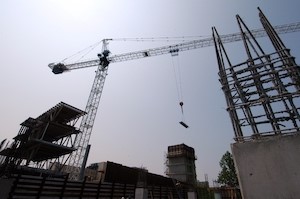Fewer cranes on the horizon across North America
For the first time in more than three years, the number of tower cranes in operation across major North American cities has declined.
 The latest edition of the North American RLB Crane Index, a twice-annual report issued by international project management advisory firm Rider Levett Bucknall, shows that the number of tower cranes in operations across 14 major cities in Canada and the United States dropped by 40. There were 415 cranes in use in the third quarter, compared with 455 in the first quarter of the year.
The latest edition of the North American RLB Crane Index, a twice-annual report issued by international project management advisory firm Rider Levett Bucknall, shows that the number of tower cranes in operations across 14 major cities in Canada and the United States dropped by 40. There were 415 cranes in use in the third quarter, compared with 455 in the first quarter of the year.
The index is a simplified measure of the current state of the construction industry’s workload in each location.
Of the cities surveyed, four experienced increases; four held steady; and five saw decreases ranging from 27 percent to 76 percent.
“In an early response to coronavirus, some cities imposed a pause on non-essential construction,” says the RLB report. “While these bans have been lifted and projects have resumed, the pandemic-induced recession is expected to have far-reaching effects. Lenders are less likely to support large, new developments in sectors that have been significantly impacted, like sports and hospitality. We are already seeing more competitive bidding for the fewer projects that are coming online.”
Toronto remains North America’s crane leader, with 124 cranes in use. In fact, the city’s crane count has increased since the first quarter of the year. Most of the cranes in use in the city are supporting residential projects, and the RLB report cautions that although the COVID-19 pandemic has not yet cut down the number of cranes in use, that could change as sales of units in high-rise residential projects have dropped by 30 percent so far in 2020.
The only other Canadian city to make RLB’s top 14 list this quarter was Calgary.
The report indicates that crane activity in the city has held steady since the first quarter of the year. While some residential and commercial projects have been completed, three new cranes have been erected to build a bridge across the Bow River.
Those cities reporting significant decreases included Chicago, Denver, Las Vegas, New York and San Francisco.
Other key findings in the report include:
- healthcare projects experienced an increase of 38 percent,
- residential projects accounted for 40 percent of all cranes counted, the most of any sector,
- mixed-use projects accounted for the second most of any sector at 25 percent,
- transportation projects increased by 80 percent compared with Q1,
- cranes dedicated to culture projects dropped by 38 percent,
- civil projects dropped by 40 percent, and
- sports projects dropped from seven to zero.








